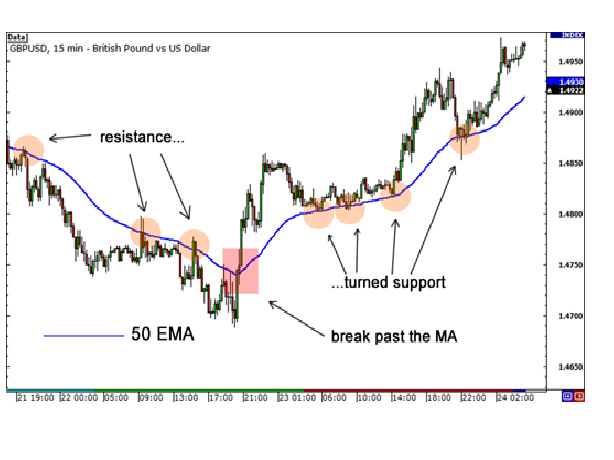Another way to use moving averages is to use them as dynamic
support and resistance levels.
We like to call it dynamic because it's not like your traditional
horizontal support and resistance lines. They are constantly changing depending
on recent price action.
There are many traders out there who look at these moving averages
as key support or resistance. These traders will buy when price dips and tests
the moving average or sell if price rises and touches the moving average.
Here's a look at the 15-minute chart of GBP/USD and pop on the 50
EMA. Let's see if it serves as dynamic support or resistance.
It looks like it held really well! Every time price approached 50 EMA and tested it, it acted as resistance and price bounced back down. Amazing, huh?
One thing you should keep in mind is that these are just like your
normal support and resistance lines.
This means that price won't always bounce perfectly from the
moving average. Sometimes it will go past it a little bit before heading back
in the direction of the trend.
There are also times when price will blast past it altogether.
What some traders do is that they pop on two moving averages, and only buy or
sell once price is in the middle of the space between the two moving averages.
You could call this area "the zone".
Let's take another look at that 15-minute chart of GBP/USD, but
this time let's use the 10 and 20 EMAs.
From the chart above, you see that price went slightly past the 10
EMA a few pips, but proceeded to drop afterwards.
There are some traders who use intraday strategies just like this.
The idea is that just like your horizontal support and resistance areas, these
moving averages should be treated like zones or areas of interest.
The area between moving averages could therefore be looked upon as
a zone of support or resistance.
Breaking through Dynamic Support and Resistance
Now you know that moving averages can potentially act as support
and resistance. Combining a couple of them, you can have yourself a nice little
zone. But you should also know that they can break, just like any support and
resistance level!
Let's take another look at the 50 EMA on GBP/USD's 15-min chart.
In the chart above, we see that the 50 EMA held as a strong
resistance level for a while as GBP/USD repeatedly bounced off it.
However, as we've highlighted with the red box, price finally
broke through and shot up. Price then retraced and tested the 50 EMA again,
which proved to be a strong support level.
So there you have it folks!
Moving averages can also act as dynamic support and resistance
levels.
One nice thing about using moving averages is that they're always
changing, which means that you can just leave it on your chart and don't have
to keep looking back in time to spot potential support and resistance levels.
You know that the line most likely represent a moving area of
interest. The only problem of course is figuring out which moving average to
use!


